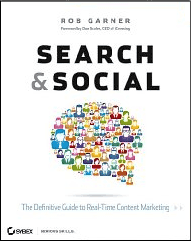Search, Social, or Both?

Search engines and social media platforms are for many Web workers the primary sources of user traffic to their digital properties. Over the past few years however, these two very different mechanisms used to drive awareness, engagement and conversion have become intermingled as search engines increasingly leverage the data provided by users on social networks including Facebook, Twitter and Google+.
To help navigate these complex virtual waters, Website Magazine interviewed Rob Garner, author of the book Search & Social about what it all means to today's enterprise. Garner is an idenpendent consultant, author, speaker and strategist, and is a widely recognized expert on the topic of interdependent search and social strategies and real-time content marketing.

WM: Why the need for a book about this topic - search and social? Aren't today's brands and Web businesses already leveraging these channels?
RG: Most businesses are engaging in each of these in some form, but they largely do not understand how the two are integrated, and how they can be better leveraging them together to gain more from their efforts. It is this intersection between the two where a new discipline has emerged. Search engines integrated social elements into the algorithms many years ago, and social has become more algorithmic. The two constantly play of each other, and the difference between being a good digital marketer and a great one is in understanding this intersection from a strategic, tactical, and logistical level. I believe that "Search and Social" is the first book to address both the intellectual case for a combined search and social discipline, and the tactical and day-to-day needs as well. This trend towards interdependency will only continue to increase its impact on the strategic and tactical aspects of a business, and the book shows how it all fits together, and how marketers can action.
WM: Are search and social complimentary marketing channels? What is the value of approaching social with a search frame of mind?
RG: Search and social are totally complementary. The game to watch in all of digital marketing is which entity combines the best technology with the best human social layer. For marketers, this means putting on your SEO hat to view your social presence, and vice versa. The fundamental way that Twitter looks at authoritative accounts is parallel to the way that Google looks at website domains for its search results. They look for theme, keyword triggers, freshness of content, external signals (links, followers, etc.). The same goes for Facebook. Google has the most robust network analysis technology, and the social networks are waking up to the fact that they need this same approach to provide a better social experience for their users. Social marketers are now finding themselves as reverse engineers to get their message across. This is a big shift from the days when social marketing was largely conversational.
WM: What role does the real-time Web play in digital success today? What "basics" of a real-time strategy can you share with WM readers?
RG: A real-time marketing presence is the new optimization, and the crux of social customer relationship management. Over the last 3 years, consumers have become almost totally networked in the United States and Europe, and these individual Internet users are comfortable interacting fluidly, and "highly addressable" by businesses. When they act fluidly and in-the-moment, they expect businesses to do the same. Real-time marketing is not a new concept, and was first written about by Regis McKenna back in 1995, and touted by many other brilliant marketers at the time. The Internet has always been real-time, but the difference between now in then is that real-time is now a daily reality for marketers. Real-time requires a human presence - an ubiquitous digital existence, if you will - in addition to a technical presence. Being present in real-time doesn't mean that marketers should go about in a harried manner, but rather that they are prepared and simply present. Being present is the new optimization, and will guarantee more visibility in search and social spaces than a passive approach.
The basics also include understanding of the evolving language of your audience, being a trusted source for content by both algorithms and audience, active conversation with your audience, real-time curation, and understanding the real-time user experience of your audience.
WM: What role does preliminary research play in the execution of search and social marketing campaigns? How should brands prepare?
RG: Preliminary research is critical to an effective search and social strategy. Even if businesses are already engaged in search and social, they should go back and assess their audience - who they are, how they communicate, and where they congregate. Stepping back and asking the question of "why?" helps to provide key focus for your strategy as well, and I believe every business should thoroughly consider this question in preliminary research. Businesses should also study the history of language used by their audience (keyword research and content popularity), but also study how language evolves in real-time as well.
WM: Any guidance for engaging in online communities? What drives response from today's digital consumer?
RG: Of course there are all the standard considerations - be transparent, non-salesy, helpful, and sincere. One key area is being present as conversations are happening, and try to strike like lightning when someone is seeking information. Consumers like a fast and knowledgeable response, and this is one of the toughest challenges for businesses. To be fast, you must prepare well in advance by knowing the keyword language of your audience in order to active listening tools that will help you find them. For example, if you sell laptop computers and support via social CRM, then it would be wise to monitor forums, social networks, and answer sites for questions related to the term "laptop computers." As questions arise, you are able to quickly jump in because you are already listening. Again, response from digital consumers comes from being knowledgeable, authoritative, and being fluid in your responses.
WM: If you were to advise WM readers on one metric/measurement to determine a combined search/social success, what would it be?
RG: If a robust content, SEO, and social strategies are in place, I would recommend looking at the network reach of your efforts. This is found in a variety of ways in different social networks (Ripples in G+, network reach in Facebook, retweets in Twitter, etc.). The core of this philosophy is to get out of the "one-to-many" approach to communication, and extending it to "many-to-many." Network reach metrics help you gain a sense of how your efforts are working.









